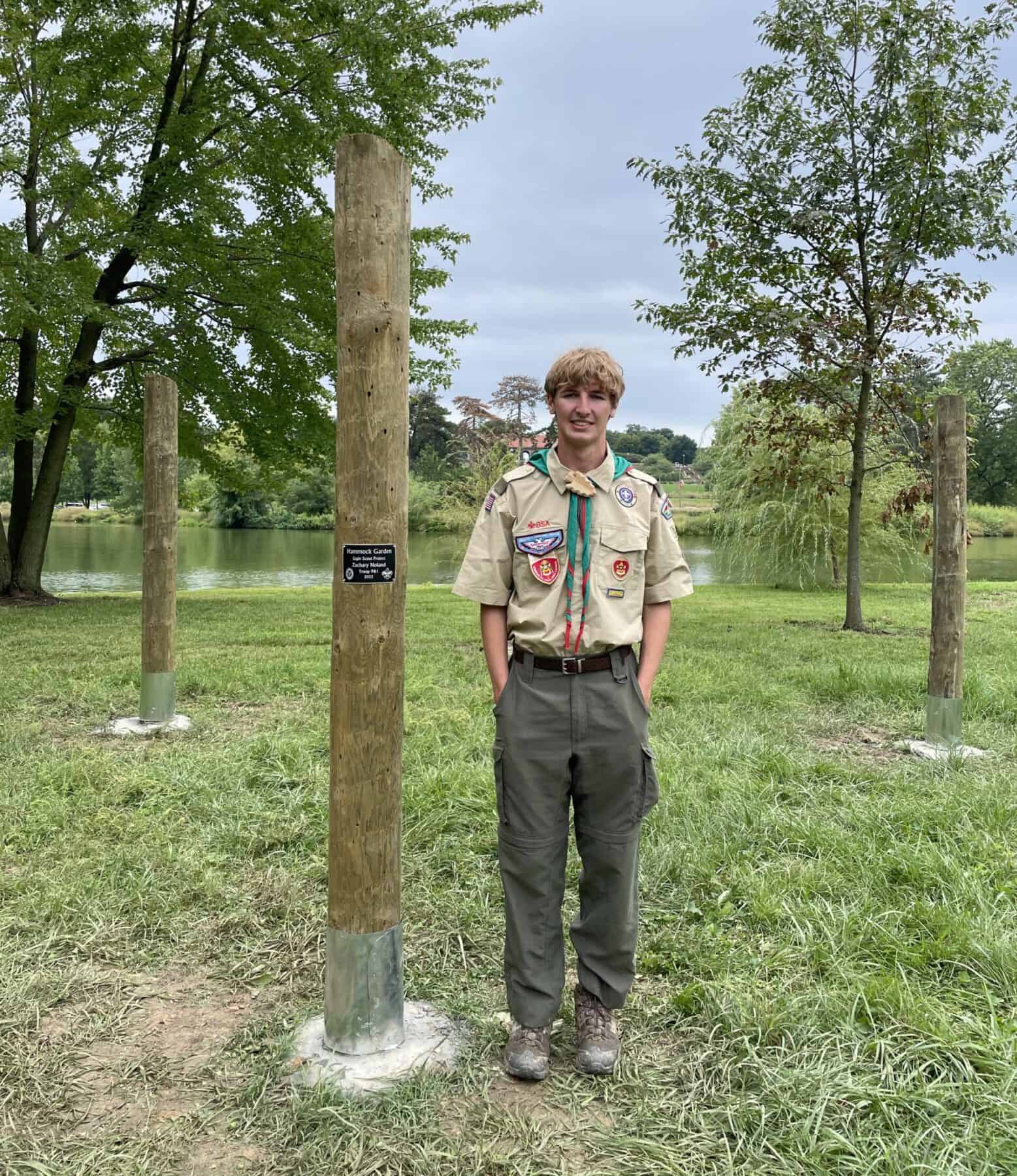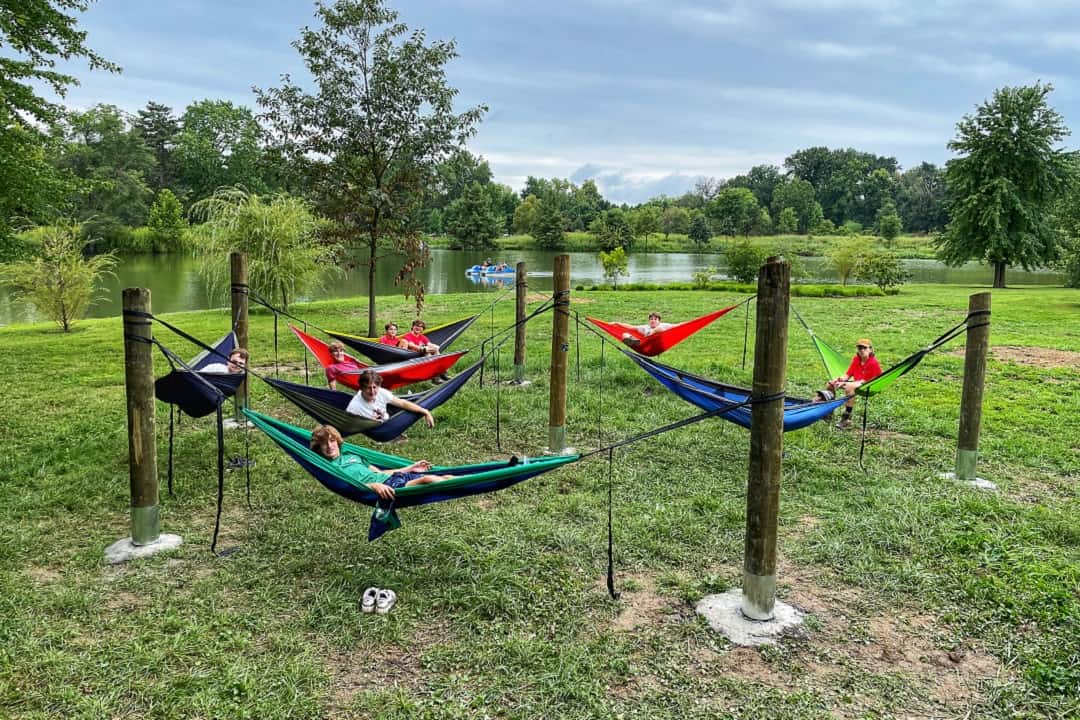On Labor Day weekend of 2022, Forest Park’s first “hammock garden” opened to the public. With space for up to 12 hammocks, the garden consists of seven posts — one in the center, with six additional in the shape of a hexagon, similar to a wheel with spokes. Located just off the walking trail next to the Post-Dispatch Lake, the garden provides the perfect balance of quiet views and group hangs.
The hammock garden was an Eagle Scout project conceptualized and built by Zachary Noland, a high school senior from Kirkwood. Hammocking has been part of his scouting experience since he was a Cub Scout in first grade. At camps and various events over the years, his peers and scout leaders set up hammocks either for sleeping or just relaxing.
Noland said, “In order to achieve the rank of Eagle Scout, you have to do some kind of Eagle project. You have creative freedom, but the project is intended to benefit the community.” Project ideas must go through a board of review and receive approval before an individual can start the project, ensuring that the project will be effective on a large enough scale, as well as confirming that people and/or an organization is willing to host the implementation of the project.
Noland’s idea for the hammock garden project originated during the COVID-19 pandemic. He and his buddies wanted to socialize outdoors, so they started hammocking. “It slowly became a group effort, and we just started hanging out. Whoever showed up, showed up,” he said.
Noland started researching the hammock garden concept, and while he thought he may have made up the idea, he discovered a small number of these structures with different names, including hammock villages and hotels. For this project, he coined the term “hammock garden.”
Once Noland had the concept for his Eagle Scout project, he had to find a location to build it. After a few dead ends at various parks in the St. Louis area, he connected with Forest Park Forever, the nonprofit conservancy that partners with the City of St. Louis to help maintain the eponymous park.
Dominik Jansky, director of communications and marketing for Forest Park Forever, said, “We occasionally receive inquiries about where people can use a hammock, and our arborists have put a lot of thought and care into maintaining trees to ideally last for generations, so it’s great to now have a designated spot for hammocks.”
The hammock garden provides a spot for visitors to put up their hammocks, relax, and enjoy some downtime during their visit to the park, without causing any damage to the natural environment.
After Noland got initial approval to build a hammock garden, he had to identify the exact location. He was given five different possible sites and settled on the current location due to proximity to parking, bathrooms, shade, level terrain, and minimal noise. For park visitors, the site is easy to locate because it is near the Boathouse, a centralized location within the park.

Eagle Scout Zachary Noland. (Amy Noland)
Once he had permissions and project approval, Noland had to orchestrate everything, including where to procure materials, how to transport them to the park, building a volunteer list, and getting a large group of people willing to work at the park. Noland says he recruited lots of Boy Scouts, friends, and family members.
The work started on a Saturday. Noland and his crew dug the holes, making sure they met width and depth specifications. When the holes were ready, he called the vice president of Forest Park Forever to inspect every one. Next, the poles were set and the holes were filled with concrete. They set up supports and fenced off the area. They completed a second workday a month later in the rain. Then, they had to take down the supports and remove the fencing. Finally, they installed the metal sheets at the base of each post and a plaque on the center one.
For Noland, “As an experience, it was very educational. There’s a lot I learned — not just how to dig holes in Forest Park — the process of knowing what questions to ask, what to focus on when doing a big project. Lots of communication.”
Since the garden’s completion, Jansky says Forest Park staff have seen people of a range of ages using the garden, just enjoying being outside, with some great views and the sounds of wildlife.
Noland says he has spent time at the hammock garden on a few occasions since its completion. “Looking back on the project, it was a lot of work, but I’m glad I did it. I’m glad what I have done has gotten a lot of attention,” he said.
To create more of a buzz about the garden and therefore more use by the community, Noland encourages people to use the hashtag #hammockingforestpark when they post to social media. For him, the more people bring their hammocks and enjoy the garden, the more worthwhile the project becomes, ultimately fulfilling the purpose of an Eagle Scout project.
Author: Missy Phegley is a regular contributor to Terrain Magazine.
Top Image: Zachary Noland (foreground) and friends hanging out at the Forest Park Hammock Garden. (Amy Noland)


Leave A Comment